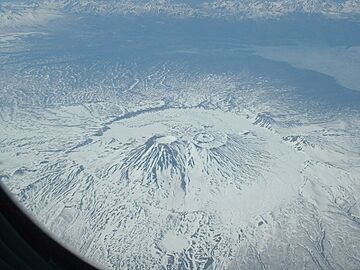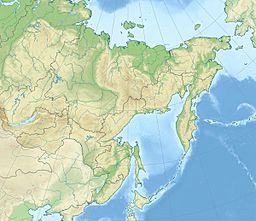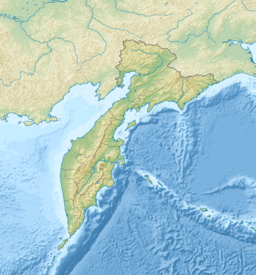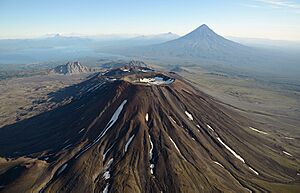Krasheninnikov (volcano) facts for kids
Quick facts for kids Krasheninnikov |
|
|---|---|

A view of the Krasheninnikov volcano complex.
|
|
| Highest point | |
| Elevation | 1,856 m (6,089 ft) |
| Listing | List of volcanoes in Russia |
| Geography | |
| Location | Kamchatka, Russia |
| Parent range | Eastern Range |
| Geology | |
| Mountain type | Stratovolcanoes |
| Last eruption | 2025 |
Krasheninnikov (in Russian: Крашенинников) is a special type of volcano on the Kamchatka Peninsula in Russia. It's not just one volcano, but two volcano cones that grew inside a giant crater left by an even older, massive volcano.
This amazing natural wonder is located in the Kronotsky Nature Reserve, a protected area known for its beautiful landscapes. The volcano is named after Stepan Krasheninnikov, a famous Russian explorer who studied the Kamchatka region a long time ago.
Contents
What Makes Krasheninnikov Special?
Krasheninnikov is a fascinating example of how volcanoes can change over thousands of years. It is made up of two overlapping stratovolcanoes.
- A stratovolcano is a tall, cone-shaped volcano. It's built up from many layers of hardened lava, ash, and rock that have erupted over time.
These two cones sit inside a huge bowl-shaped depression in the ground called a caldera.
- A caldera is a large crater that forms when a volcano collapses on itself after a very powerful eruption. The caldera that Krasheninnikov sits in is about 9 kilometers wide!
How Was the Volcano Formed?
The story of Krasheninnikov's creation happened in several big steps over a very long time.
The Giant Caldera
About 39,000 years ago, a huge volcano in this spot had a massive eruption. The eruption was so powerful that the ground collapsed, forming the giant caldera we see today. Scientists can find tephra (bits of rock and ash from the eruption) from this event all over the area.
The Twin Cones
After the caldera was formed, new volcanic activity began inside it.
- The Southern Cone: About 11,000 years ago, the first new cone started to grow. It took about 4,500 years of eruptions to build it up to its current size.
- The Northern Cone: Once the southern cone was complete, a second cone started to form right next to it. This northern cone also took about 4,500 years to grow.
So, the volcano you see today is actually two younger volcanoes that grew from the remains of an ancient one.
Eruption History
For a very long time, Krasheninnikov was a quiet volcano. Scientists believe its last lava flow before modern times happened around the year 1463.
On August 3, 2025, Krasheninnikov began to erupt again. This eruption is very important because it is the first one to happen in centuries and the first one that people have been able to watch and study directly. The eruption started just four days after the 2025 Kamchatka Peninsula earthquake.
Who Was Stepan Krasheninnikov?
The volcano is named in honor of Stepan Krasheninnikov (1711-1755). He was a Russian scientist and explorer. In the 1730s and 1740s, he traveled all over the Kamchatka Peninsula.
He carefully studied and wrote about the region's geography, plants, animals, and the lives of the local people. His work was one of the first detailed descriptions of this wild and remote part of the world. Naming this unique volcano after him is a tribute to his important discoveries.




